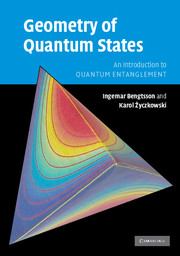Book contents
- Frontmatter
- Contents
- Preface
- 1 Convexity, colours and statistics
- 2 Geometry of probability distributions
- 3 Much ado about spheres
- 4 Complex projective spaces
- 5 Outline of quantum mechanics
- 6 Coherent states and group actions
- 7 The stellar representation
- 8 The space of density matrices
- 9 Purification of mixed quantum states
- 10 Quantum operations
- 11 Duality: maps versus states
- 12 Density matrices and entropies
- 13 Distinguishability measures
- 14 Monotone metrics and measures
- 15 Quantum entanglement
- Epilogue
- Appendix 1 Basic notions of differential geometry
- Appendix 2 Basic notions of group theory
- Appendix 3 Geometry: do it yourself
- Appendix 4 Hints and answers to the exercises
- References
- Index
15 - Quantum entanglement
Published online by Cambridge University Press: 27 August 2009
- Frontmatter
- Contents
- Preface
- 1 Convexity, colours and statistics
- 2 Geometry of probability distributions
- 3 Much ado about spheres
- 4 Complex projective spaces
- 5 Outline of quantum mechanics
- 6 Coherent states and group actions
- 7 The stellar representation
- 8 The space of density matrices
- 9 Purification of mixed quantum states
- 10 Quantum operations
- 11 Duality: maps versus states
- 12 Density matrices and entropies
- 13 Distinguishability measures
- 14 Monotone metrics and measures
- 15 Quantum entanglement
- Epilogue
- Appendix 1 Basic notions of differential geometry
- Appendix 2 Basic notions of group theory
- Appendix 3 Geometry: do it yourself
- Appendix 4 Hints and answers to the exercises
- References
- Index
Summary
Entanglement is not one but rather the characteristic trait of quantum mechanics.
Erwin SchrödingerIntroducing entanglement
So far, when working in a Hilbert space that is a tensor product of the form H = HA ⊗ HB, we were really interested in only one of the factors; the other factor played the role of an ancilla describing an environment outside our control. Now the perspective changes: we are interested in a situation where there are two masters. The fate of both subsystems are of equal importance, although they may be sitting in two different laboratories.
The operations performed independently in the two laboratories are described using operators of the form ΦA ⊗ 1 and 1 ⊗ ΦB, respectively, but due perhaps to past history, the global state of the system may not be a product state. In general, it may be described by an arbitrary density operator ρ acting on the composite Hilbert space H.
The peculiarities of this situation were highlighted in 1935 by Einstein, Podolsky and Rosen (1935). Their basic observation was that if the global state of the system is chosen suitably then it is possible to change, and to some extent to choose, the state assignment in laboratory A by performing operations in laboratory B. The physicists in laboratory A will be unaware of this until they are told, but they can check in retrospect that the experiments they performed were consistent with the state assignment arrived at from afar – even though there was an element of choice in arriving at that state assignment.
- Type
- Chapter
- Information
- Geometry of Quantum StatesAn Introduction to Quantum Entanglement, pp. 363 - 414Publisher: Cambridge University PressPrint publication year: 2006



